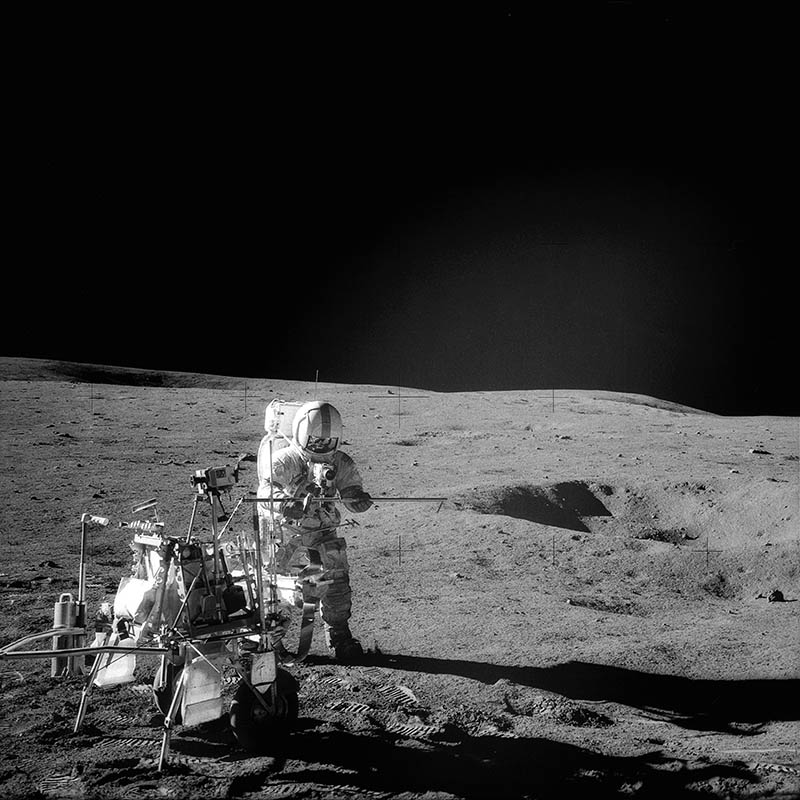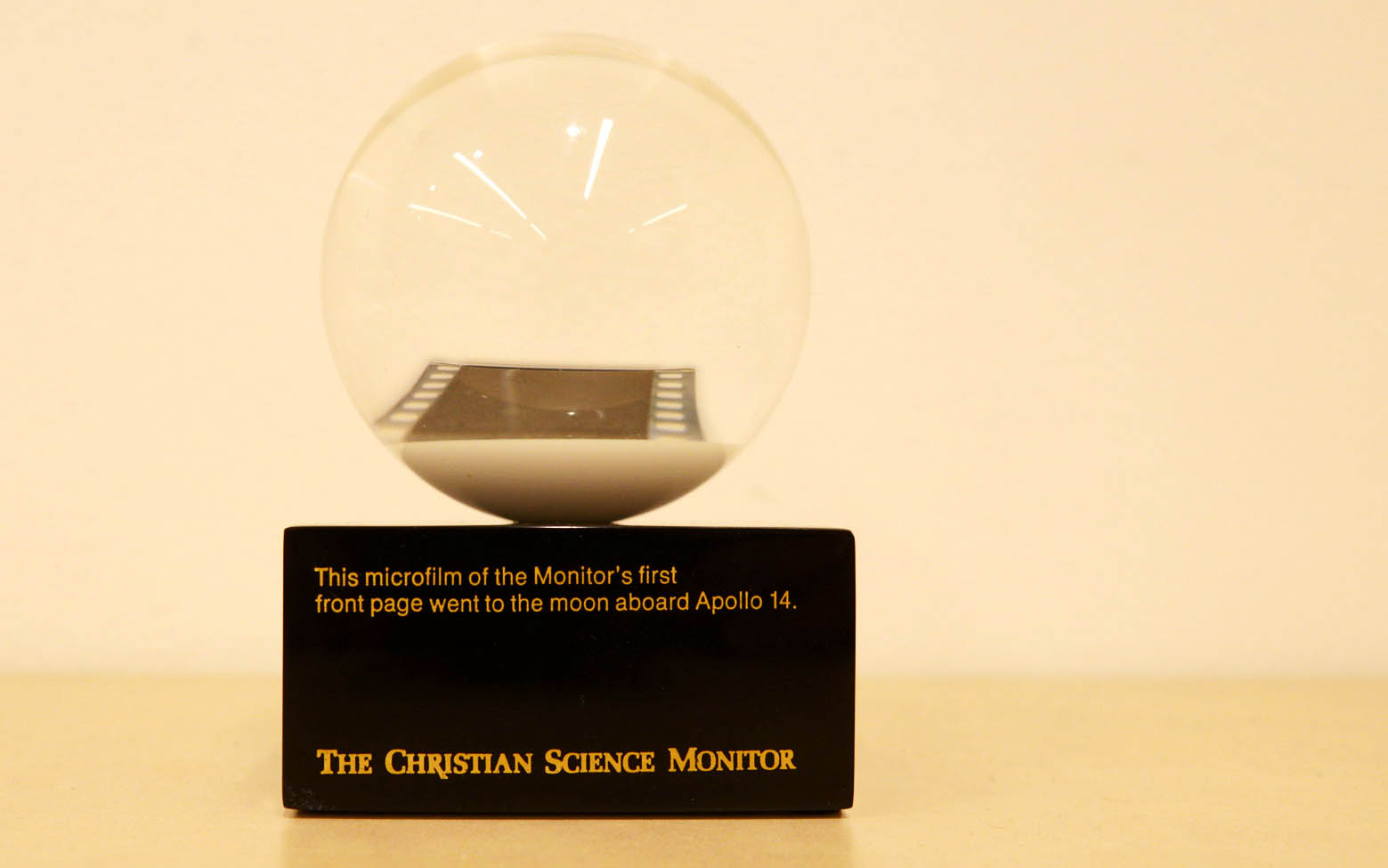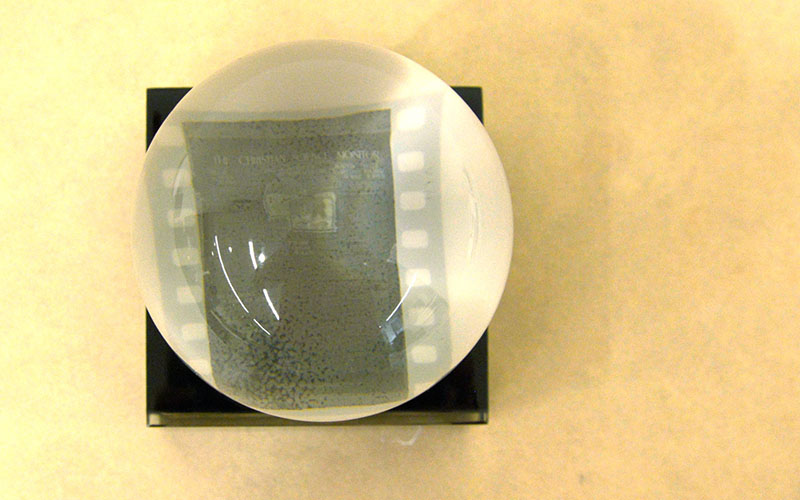From the Collections: The Monitor on the moon

Astronaut Alan Shepard uses a portable workbench during the Apollo 14 Moon mission, February 5, 1971. Courtesy of NASA/JSC.
On February 6, 1971, in a front-page story, The Christian Science Monitor alerted readers that Apollo 14 had landed safely on the moon. Grainy images filled the broadsheet, showing astronauts Alan B. Shepard, Jr. (1923–1998) and Edgar Mitchell (1930–2016) completing their first moonwalk. By then that sight was already familiar to the American public—it was America’s third lunar mission.1
After the extraordinary Apollo 11 moon landing in 1969, readers may have been becoming disinterested in repeated lunar landings.2 But on the same page another, smaller headline was included: “Monitor on Moon.” With very little fanfare, the international newspaper reported that Shepard had brought with him a copy of its first edition.3 For dedicated subscribers, this was bound to garner interest.
Shepard had become the first American in space on May 5, 1961. He led the Apollo 14 mission, which in addition to Mitchell included Stuart Roosa (1933–1994). The liftoff took place on January 31, 1971, with a return to Earth nine days later. The three astronauts spent a total of 33 ½ hours orbiting and walking on the moon. The purpose of Apollo 14 was mainly to gather scientific information, and the crew brought 108 pounds of rock and soil samples back to Earth.4 Although Mitchell and Shepard were not able to reach a crater, as originally planned, the team encountered very few problems and completed two spacewalks.5
Shepard even celebrated the moment by hitting two golf balls onto the lunar surface with a club.6
Officials at the National Aeronautics and Space Administration (NASA) were initially worried about the success of Shepard and his team. In April 1970, Apollo 13 was supposed to land on the moon, but an emergency in orbit had forced its return to Earth, causing doubt that additional launches into space would be successful. The Monitor summed up those feelings on January 30, 1971:
The $1.6 billion budgeted for Apollo in 1970 fiscal year will sag to a mere $600 million in the 1972 fiscal year…. And if Apollo 14 aborted, maybe even the three remaining Apollos, shortened already by two, would be canceled.7
But the Monitor did arrive on the moon February 5, 1971. And it accompanied Shepard during his first moonwalk that day. Shepard was able to bring the complete first edition, as well as 100 copies of its front page. This was because NASA was able to reduce the size of the paper by printing it on microfilm, a type of small filmstrip viewable with specialized equipment. 8
But how was the Monitor able to reach outer space? It was thanks to Joyce Becker, a Monitor advertising representative living in Houston, Texas. She was friendly with Shepard’s wife, Louise. One day after services at Third Church of Christ, Scientist, Houston, Becker brought up the idea. Ralph C. Charbeneau, then Manager of the Promotion Department at The Christian Science Publishing Society in Boston, described the course of events in a memo to Manager Robert Bergenheim:
Mr. Shepard said he had in fact already agreed to take the front page of two other newspapers with him but would be glad to take the Monitor. We have all agreed that a microfilm version of the entire issue of the Monitor gives us certain promotional advantages rather than being merely an “also ran” with our front page there too.
We have packaged the microfilmed original issue of the Monitor in a small 35 mm film can (as round as a half dollar and about 1 3/4″ high). We are also adding as many additional microfilmed front pages of that issue as the can will hold. We expect 50 to 75.
Upon their return from the moon we plan an appropriate mounting of each of these, probably suspended in a sphere of clear lucite plastic and bearing suitable copy.9
None of those 100 microfilm copies was left among the lunar rock; they all completed the 1,150,321 mile excursion from the Earth to the moon and back.10

Photograph of a souvenir globe containing a microfilm front page
of The Christian Science Monitor from Apollo 14.
The Monitor was not the first non-scientific text brought into space. The Apollo Prayer League, formed in 1968 by NASA astronauts, had made it their mission to bring a copy of the King James Bible to the moon. After several failed attempts on Apollos 12 and 13, they were able to fulfill this goal on Apollo 14. While Shepard carried the Monitor on the mission’s first moonwalk, Mitchell brought 300 microfilm copies of the Bible.11
Nor was the Monitor the only newspaper on board Antara, Apollo 14’s lunar module. After much effort, Al Neuharth, publisher of Today (now Florida Today), convinced Shepard to take copies of that publication to the moon as well—although he didn’t honor an additional request that it be left behind when the mission returned to Earth.12
The Monitor copies that went on Apollo 14 were later encased in globals and given out as momentos13—and The Mary Baker Eddy Library’s collections hold one of them. The paper also ran its own promotion, in which readers could, for three dollars, take part in Apollo 14 with their own “full-size reprints” of the historic first edition.14 So, while moon landings may have become uninteresting news to some by 1971, this unique story—and the chance to join in the experience—certainly gained attention.

The Mary Baker Eddy Library’s own copy of the Monitor that went to the surface of the moon.
On November 25, 1908—its first day of publication—the Monitor had published an article with this headline: “LIFE ON MARS MAY BE SHOWN.”15 It seems fitting, then, that just as its first edition detailed humanity’s search for knowledge, a much later issue would join Apollo 14 in its mission to advance scientific understanding. By then the Monitor had grown from its humble beginnings to become a successful international newspaper. Having gone to the moon, it had literally reached a new height. But no doubt the significance was not lost on Shepard, who was friendly to Christian Science and likely appreciated the deeper meaning of this accomplishment.16
- “Monitor on moon,” The Christian Science Monitor, 6 February 1971, 1.
- “Spaceflight fervor—descent path,” The Christian Science Monitor, 9 February 1971, 1.
- “Monitor on moon,” 6 February 1971, 1.
- “Apollo bringing pay dirt,” The Christian Science Monitor, 8 February 1971, 1.
- “What Apollo is all about: the moonwalks,” The Christian Science Monitor, 3 February 1971, 1.
- “Head, Golf Club, Apollo 14, Replica,” airandspace.si.edu. https://airandspace.si.edu/collection-objects/head-golf-club-apollo-14-replica/nasm_A19751468000.
- “Apollo 14 poised at the brink,” The Christian Science Monitor, 30 January 1971, 1.
- “Microfilm,” archives.gov. https://www.archives.gov/preservation/formats/microfilming.html
- Charbeneau to Bergenheim, Church Archives, Box 3584, Folder 134533.
- “Apollo 14,” nasa.gov. https://www.nasa.gov/mission_pages/apollo/missions/apollo14.html.
- “The Lunar Bible,” museumofthebible.org. https://collections.museumofthebible.org/artifacts/44736-the-lunar-bible?&tab=description
- “Bring a newspaper to the moon? NASA said no, LBJ said no. Astronaut Alan Shepard said yes,” Florida Today, 22 June 2021.
- Charbeneau to Bergenheim, Church Archives, Box 3584, Folder 134533.
- “1908 Monitor Journeys To Moon,” The Christian Science Monitor, 13 February 1971, 8.
- “LIFE ON MARS MAY BE SHOWN,” The Christian Science Monitor, 25 November 1908, 8.
- National Aeronautics and Space Administration, “Press Conference Mercury Astronaut Team,” osu.edu. https://library.osu.edu/site/friendship7/files/2017/06/PressConference.pdf

